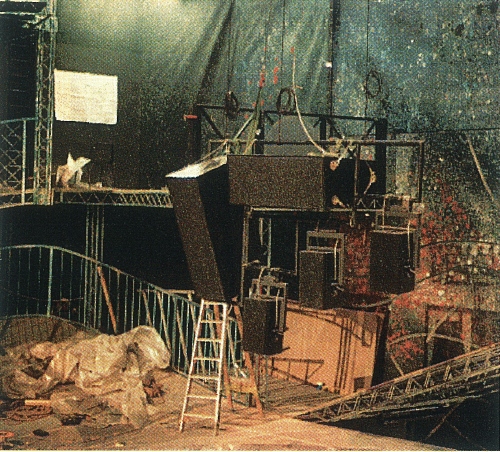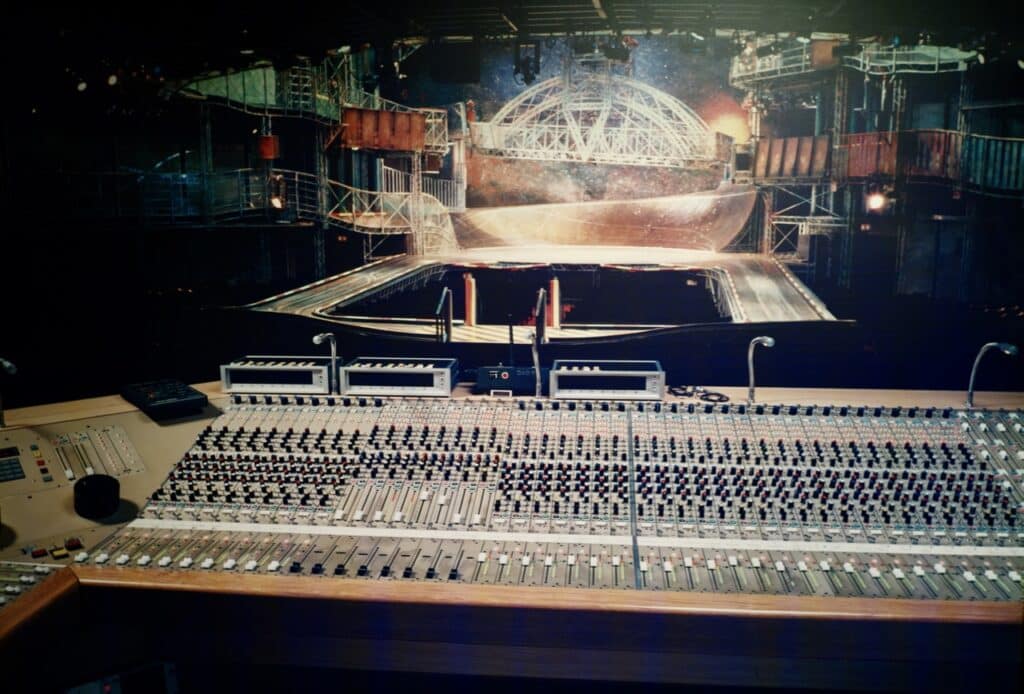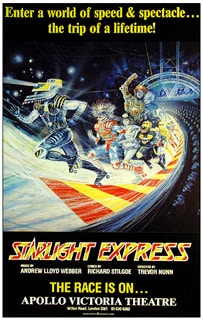Our Hires
Find out about our extensive hire services.
Tell Me MoreMarch 27th 2024, London
The original London production of Andrew Lloyd-Webber’s Starlight Express opened at the Apollo Victoria Theatre on this very day, forty years ago. Directed by Trevor Nunn with choreography for the roller skaters by Arlene Phillips, the extraordinary and ground-breaking set design was by John Napier while, in our world, the sound designer was Martin Levan with our own Andrew Bruce at the centre of the action.
“On a technical level, the audio requirements were significantly beyond anything that we’d done before” Andrew recalls. “Starlight was by far the most technically ambitious theatre project at that time, which posed huge challenges for every department, not least sound. For us, the exceptionally quirky custom console, the quantity of radio mic channels, the comms system and the sheer size of the installation that the show demanded all represented a major shift of scale for us.”

Band PA Cluster including Meyer Sound MSL-3 and UPA-1 enclosures
As was fairly routine at the time (and unbelievable today!), Autograph had commissioned a one-off audio mixing console from Cadac, designed specifically for the system, the show and the theatre, which would have no use whatsoever beyond Starlight Express.
Andrew continues, “It consisted of two consoles in one; a vocal console that only routed to two buses and an orchestral console that routed to many more with the equivalent of a monitor matrix on every channel, using screwdriver pots rather than switches to route to the groups. It was designed to fit with the concept of the show, where the back wall of the stage was to be composed of just loudspeakers, with every loudspeaker being a different instrument or section of the band. It didn’t quite work out that way, but it came close.”
In yet another glimpse of the future that was being created, the Cadac also featured some very early console automation features, notably the embryonic fader automation which later gave birth to Cadac’s E-type fader system. Andrew again: “You could program a series of cues that brought the elements you wanted to the central VCA section, so the operator wasn’t scooting up and down a huge console trying to find things in the dark. That was the beginning of a real sea change in the way mixing in the theatre developed; the idea that things should come to you – and that required computer help.”

The now-legendary Cadac mixing console, built just for Starlight Express
Meanwhile in RF world things were no less exciting, as Andrew explains:
“The use of radio microphones had been integral to the conception of the show and any other technique would have been completely unworkable. But the size and nature of the spectacle required a minimum of 21 radio frequencies, of which all but three would have to be illegal for anyone apart from broadcasters to use.”
Ultimately, after the show’s infamous first night (of which more anon) this vital element of British musical theatre was instantly catapulted into a painful but necessary examination of the use of RF spectrum by the entire entertainment industry, which resulted in the access to the wireless channels that we have today. “That alone means that Starlight Express ended up being a major catalyst for change.”
At the remove of some four decades it’s easy to forget the impact that Starlight had and in fact continues to have. Our friend and regular collaborator, lighting director extraordinaire, respected industry journalist and theatre historian Rob Halliday comments:
“Cats and Starlight Express between them are the ‘origin stories’ for all of that next generation of big, epic shows and so really the whole ‘mega show’ scene in Las Vegas. This is partly because of their scale and ambition (‘…rip out the whole theatre and build what we want…’) and of course mainly because of the people – John Napier leading the way (designing the Siegfried and Roy show), David Hersey (lighting the Wynn hotels and the pirate show outside Treasure Island) in lighting and in sound most particularly Jonathan Deans (all of those Cirque shows, EFX and more) and of course Martin Levan’s work on many shows including Starlight itself.
I also think that Starlight was the first of what we’re now seeing called ‘immersive’ shows, with the audience in the middle of the action and the action coming out to envelop them, rather than just sitting in a seat watching a show on a picture frame stage. I do remember as a kid sitting in one of the stalls seats in the middle of the race track – it was thrilling…”

Original 1984 show poster. Credit: Dewynters publishing
There is of course much, much more to this story, as the above is just a snapshot of some of the elements that made Starlight Express such a milestone in the evolution of technical musical theatre and its ability to deliver the developing creative vision of producers, directors, writers and composers.
Happily, that story (including all the production technologies applied) will be told in full soon, as Rob is working on a feature-length article for Lighting & Sound International magazine which will be published later in the year. Don’t miss it!